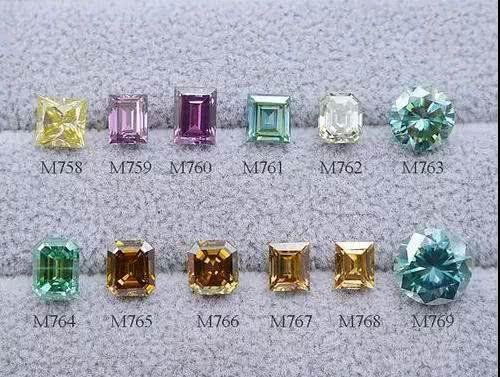Moissanite Color Characteristics
Moissanite gemstones are assessed for color quality using strict criteria, with color being a crucial factor in determining their value. They can exhibit a range of colors, including colorless to pale yellow as well as various hues like yellow, purple, blue, green, and bluish-green.
Diamond Color Grading System
Diamonds are graded for color using a system established by the Gemological Institute of America (GIA). This system classifies diamonds into 23 continuous color grades ranging from colorless to light yellow or light brown, represented by letters from D to Z. D represents a completely colorless diamond, while subsequent letters indicate varying degrees of yellow or brown tint.
GIA categorizes diamond colors into five main groups:
- Colorless (D-F): The rarest and most valuable diamonds, with D being entirely colorless.
- Near-Colorless (G-J): Colors that are difficult to discern for most people without gemological training.
- Faint (K-M): Colors that may still be challenging for untrained observers to perceive.
- Very Light (N-R): Colors faintly visible to untrained observers in larger diamonds.
- Light (S-Z): These colors are visible in diamonds of various sizes, manifesting as a faint yellow or brown tinge, though not to the extent of being considered “fancy” colored diamonds.

Moissanite Color Grading
The highest grade for moissanite is represented by D, with subsequent letters indicating a more noticeable yellowish undertone, signifying lower color grades. Evaluating moissanite color requires viewing the gemstone against a white background to facilitate accurate differentiation. Larger moissanite gemstones tend to display their colors more prominently.
Moissanite vs. Diamonds
Moissanite may resemble diamonds at first glance, but a closer inspection reveals its more intense play of colors. In professional assessments using specialized instruments, moissanite’s play of colors is 2.5 times more pronounced than that of diamonds. Moissanites surpasses diamonds in both dispersion (0.104 vs. 0.044) and refractive index (2.65 vs. 2.417), making it more vibrant and brilliant. Moissanites also has a Mohs hardness of 9.25, slightly lower than diamonds but still highly durable and resistant to scratching and chipping.
Advantages of Moissanites
- Moissanite closely resembles diamonds in structure and appearance, often mistaken for diamonds when tested.
- Moissanite outshines diamonds in brilliance and play of colors.
- Moissanite is significantly more affordable, costing only a fraction of the price of diamonds.
- High refractive index, dispersion, and luster result in exceptional brilliance.
- Mohs hardness of 9.25 ensures durability and resistance to damage, rivaling diamonds in toughness.






